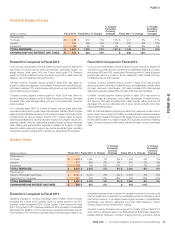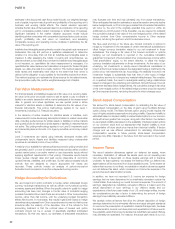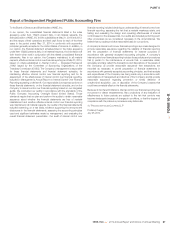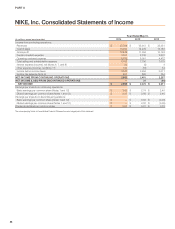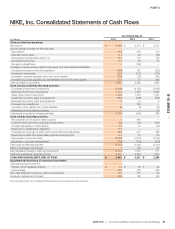Nike 2014 Annual Report Download - page 38
Download and view the complete annual report
Please find page 38 of the 2014 Nike annual report below. You can navigate through the pages in the report by either clicking on the pages listed below, or by using the keyword search tool below to find specific information within the annual report.
PART II
As part of our revenue recognition policy, we record estimated sales returns,
discounts, and miscellaneous claims from customers as reductions to
revenues at the time revenues are recorded. Our post invoice sales discounts
consist of contractual programs with certain customers or discretionary
discounts that are expected to be granted to certain customers at a later date.
We base our estimates on historical rates of product returns, discounts and
claims, specific identification of outstanding claims and outstanding returns
not yet received from customers, and estimated returns, discounts, and
claims expected but not yet finalized with our customers. Actual returns,
discounts, and claims in any future period are inherently uncertain and thus
may differ from our estimates. If actual or expected future returns, discounts,
and claims were significantly greater or lower than the reserves we had
established, we would record a reduction or increase to net revenues in the
period in which we made such determination.
Allowance for Uncollectible Accounts
Receivable
We make ongoing estimates relating to the ability to collect our accounts
receivable and maintain an allowance for estimated losses resulting from the
inability of our customers to make required payments. In determining the
amount of the allowance, we consider our historical level of credit losses and
make judgments about the creditworthiness of significant customers based
on ongoing credit evaluations. Since we cannot predict future changes in the
financial stability of our customers, actual future losses from uncollectible
accounts may differ from our estimates. If the financial condition of our
customers were to deteriorate, resulting in their inability to make payments, a
larger allowance might be required. In the event we determine that a smaller
or larger allowance is appropriate, we would record a credit or a charge to
Operating overhead expense in the period in which such a determination is
made.
Inventory Reserves
We also make ongoing estimates relating to the net realizable value of
inventories based upon our assumptions about future demand and market
conditions. If we estimate that the net realizable value of our inventory is less
than the cost of the inventory recorded on our books, we record a reserve
equal to the difference between the cost of the inventory and the estimated
net realizable value. This reserve is recorded as a charge to Cost of sales. If
changes in market conditions result in reductions in the estimated net
realizable value of our inventory below our previous estimate, we would
increase our reserve in the period in which we made such a determination and
record a charge to Cost of sales.
Contingent Payments under Endorsement
Contracts
A significant portion of our Demand creation expense relates to payments
under endorsement contracts. In general, endorsement payments are
expensed uniformly over the term of the contract. However, certain contract
elements may be accounted for differently, based upon the facts and
circumstances of each individual contract.
Certain contracts provide for contingent payments to endorsers based upon
specific achievements in their sports (e.g., winning a championship). We
record demand creation expense for these amounts when the endorser
achieves the specific goal.
Certain contracts provide for variable payments based upon endorsers
maintaining a level of performance in their sport over an extended period of
time (e.g., maintaining a specified ranking in a sport for a year). These
amounts are reported in Demand creation expense when we determine that it
is probable that the specified level of performance will be maintained
throughout the period. In these instances, to the extent that actual payments
to the endorser differ from our estimate due to changes in the endorser’s
performance, increased or decreased Demand creation expense may be
reported in a future period.
Certain contracts provide for royalty payments to endorsers based upon a
predetermined percentage of sales of particular products. We expense these
payments in Cost of sales as the related sales occur. In certain contracts, we
offer minimum guaranteed royalty payments. For contracts for which we
estimate we will not meet the minimum guaranteed amount of royalty fees
through sales of product, we record the amount of the guaranteed payment in
excess of that earned through sales of product in Demand creation expense
uniformly over the remaining guarantee period.
Property, Plant and Equipment and Definite-
Lived Assets
Property, plant and equipment, including buildings, equipment, and
computer hardware and software are recorded at cost (including, in some
cases, the cost of internal labor) and are depreciated over the estimated
useful life. Changes in circumstances (such as technological advances or
changes to our business operations) can result in differences between the
actual and estimated useful lives. In those cases where we determine that the
useful life of a long-lived asset should be shortened, we increase depreciation
expense over the remaining useful life to depreciate the asset’s net book value
to its salvage value.
We review the carrying value of long-lived assets or asset groups to be used
in operations whenever events or changes in circumstances indicate that the
carrying amount of the assets might not be recoverable. Factors that would
necessitate an impairment assessment include a significant adverse change
in the extent or manner in which an asset is used, a significant adverse
change in legal factors or the business climate that could affect the value of
the asset, or a significant decline in the observable market value of an asset,
among others. If such facts indicate a potential impairment, we would assess
the recoverability of an asset group by determining if the carrying value of the
asset group exceeds the sum of the projected undiscounted cash flows
expected to result from the use and eventual disposition of the assets over the
remaining economic life of the primary asset in the asset group. If the
recoverability test indicates that the carrying value of the asset group is not
recoverable, we will estimate the fair value of the asset group using
appropriate valuation methodologies that would typically include an estimate
of discounted cash flows. Any impairment would be measured as the
difference between the asset group’s carrying amount and its estimated fair
value.
Goodwill and Indefinite-Lived Intangible Assets
We perform annual impairment tests on goodwill and intangible assets with
indefinite lives in the fourth quarter of each fiscal year, or when events occur or
circumstances change that would, more likely than not, reduce the fair value
of a reporting unit or an intangible asset with an indefinite life below its carrying
value. Events or changes in circumstances that may trigger interim
impairment reviews include significant changes in business climate, operating
results, planned investments in the reporting unit, planned divestitures, or an
expectation that the carrying amount may not be recoverable, among other
factors. We may first assess qualitative factors to determine whether it is more
likely than not that the fair value of a reporting unit is less than its carrying
amount. If, after assessing the totality of events and circumstances, we
determine that it is more likely than not that the fair value of the reporting unit is
greater than its carrying amount, the two-step impairment test is
unnecessary. The two-step impairment test requires us to estimate the fair
value of our reporting units. If the carrying value of a reporting unit exceeds its
fair value, the goodwill of that reporting unit is potentially impaired and we
proceed to step two of the impairment analysis. In step two of the analysis, we
measure and record an impairment loss equal to the excess of the carrying
value of the reporting unit’s goodwill over its implied fair value, if any.
We generally base our measurement of the fair value of a reporting unit on a
blended analysis of the present value of future discounted cash flows and the
market valuation approach. The discounted cash flows model indicates the
fair value of the reporting unit based on the present value of the cash flows
that we expect the reporting unit to generate in the future. Our significant
NIKE, INC. 2014 Annual Report and Notice of Annual Meeting 81
FORM 10-K




